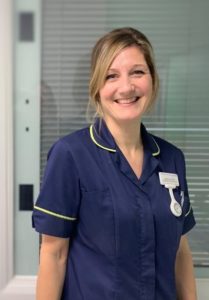By Angela Windsor, Sepsis Nurse Practitioner
 I am SaTH’s first ever Sepsis Nurse Practitioner, and as today is World Sepsis Day I want to tell you a bit about my role and some of the improvements taking place in the recognition and treatment of Sepsis at the Trust.
I am SaTH’s first ever Sepsis Nurse Practitioner, and as today is World Sepsis Day I want to tell you a bit about my role and some of the improvements taking place in the recognition and treatment of Sepsis at the Trust.
I’ve always had an interest in the deteriorating patient. Early on in my career as a Critical Care nurse I saw how early intervention could halt conditions such as Sepsis. Later, as a Resuscitation Officer, I educated staff in advanced life support and how to identify patients who might respond well to treatment.
There is a huge correlation between the early recognition and treatment of Sepsis (within one hour), and patient survival and recovery, so my experience has really helped me in my role as Sepsis Nurse Practitioner.
My job is to ensure that staff can identify the risk of Sepsis in patients with signs of infection and ensure that, once this risk been identified, patients with ‘Red flag’ symptoms receive their bundle of care within a 60 minute time frame. Every ward and most clinical areas have a Sepsis Trolley or Sepsis box, which has all the necessary equipment to help staff intervene in suspected Sepsis cases.
but here is where it becomes more complicated.
Sepsis is not a type of infection, but rather the body’s response to an infection that has gone into overdrive. Many sick patients will have symptoms similar to Sepsis without having the condition itself, so we must use tools to help us identify and treat those most at risk until we can either confirm or rule out Sepsis.
SaTH has developed its own tools to assist with this process, and I spend time working closely with teams to look at patient care and highlighting areas of excellence to show how recognition and treatment can and should be done.
I work with all new Junior Doctors at SaTH to raise awareness of Sepsis and teach them about the processes and tools we use within the Trust. I also continuously visit wards to review the equipment they have in place for the management of suspected Sepsis patients. This ongoing contact means I can offer advice on how to improve and build on their current practice to make it even more effective.
I work very closely with a variety of teams and can often be found reviewing notes to see if any improvements that can be made. If I’m working in a clinical area I will often work with staff on the treatment of real-life patients to identify Sepsis. This means we can ensure that needs are addressed immediately and prevent any delay of treatment.
No two days are the same in my role and there is nothing more rewarding that looking at a patient and knowing that the team have nailed identification and treatment within 60 minutes. It is also hugely satisfying to know that a 10 minute chat has resulted in a greater depth of understanding for a staff member and that they now feel empowered to identify patients at risk and help ensure delivery of the Sepsis care bundle.
Most important to me are the conversations I have with people who have experienced Sepsis, either as a patient or as a relative or friend of a Sepsis survivor, or of someone who succumbed to the condition. With every interaction and feedback from their experiences I can learn something new and share that information to make a difference at our hospitals.
